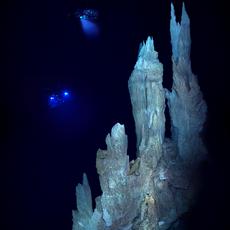Chemical formation of hydrocarbons
Lost City, a collection of large snow-white towers and hot water springs, lies at a depth of about 800 metres below the surface of the Atlantic Ocean. Its limestone chimneys up to 60 metres high bear witness to the special geochemical environment that is home to an unusual ecosystem. A new study now strengthens the theory that the hydrocarbons occurring there have a chemical origin.

Lost City, the sub-oceanic “lost city” in the Atlantic, is a hydrothermal field of hot water springs and tower-like limestone chimneys. The Earth’s upper mantle has risen up here through deep fracture zones to the surface of the sea bed, and reacts with the seawater. It causes the mantle rock peridotite to be converted into serpentinite. When the water reaches the surface again it has a temperature between 30 and 90 degrees, a strongly alkaline pH between 9 and 11, and contains large amounts of hydrogen and hydrocarbons such as methane.
Not a biological process
Although as a rule hydrocarbons are formed when micro-organisms decompose organic material, scientists have now shown that this seems not to be the case in Lost City. Gretchen Bernasconi-Green, Senior Lecturer at the Department of Earth Sciences of ETH Zurich, says: “Ever since we began our research work in Lost City we suspected that the hydrocarbon occurrences do not originate in biological processes. However, until now there has been insufficient evidence to prove this.”
Scientists had already established in earlier studies that the carbon isotope signature – the ratio of carbon-13 to carbon-12 – in Lost City’s methane is unusually large. It corresponds to that of synthetically manufactured hydrocarbons formed in Fischer-Tropsch synthesis. This process generates liquid hydrocarbons from the synthetic gases carbon monoxide and hydrogen.
Carbon from the mantle rock
The new study now shows that the hydrocarbons in Lost City are constructed in a similar way to synthetic ones. This provides further evidence that they were not formed biologically. In contrast to hydrocarbons formed biologically, those in Lost City have short chains and a low molecular weight. In addition, radiometric age dating of the carbon showed that this was probably dissolved out of the mantle rock and cannot originate from seawater because there was no longer any measurable radioactive decay. Thus the carbon must be more than 50,000 years old. Based on the latest studies, Bernasconi-Green thinks it unlikely that the seawater had an even longer residence time in Lost City’s network of hydrothermal veins. The recent studies show that it probably takes less than one million years for the entire volume of water in the oceans to circulate through the porous oceanic crust.
Bernasconi-Green is the only Swiss researcher belonging to the American research team that is now attempting to systematically rule out the biogenic origin of the hydrocarbons. The team publish their results in the scientific journal “Science”.
Lost City was discovered in 2000. At that time Gretchen Bernasconi-Green was sitting in front of the monitor screen when the camera searching the sea floor 15 kilometres away from the mid-Atlantic ridge at a latitude of 30 degrees North recorded the chimneys of the hydrothermal field. Based on the position of Lost City, far from the mid-Atlantic ridge, the researcher quickly realised that this must clearly involve hot water springs of a special kind.
Since Lost City’s discovery, NASA and some oil companies have been watching with interest the research work taking place there. Firstly, similar geochemical conditions could have allowed life to come into existence on other planets. Secondly, studies such as these strengthen the theory already put forward by Thomas Gold decades ago that the Earth’s mantle conceals undiscovered reserves of hydrocarbons formed by non-biological processes.
Literature reference
Proskurowski, G. et al.: Abiogenic Hydrocarbon Production at Lost City Hydrothermal Field, Science 319/2008. DOI: 10.1126/science.1151194







READER COMMENTS